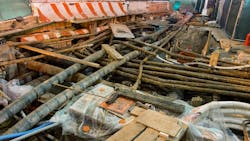Proactive Risk Management: Tackling Underground Uncertainties Upfront
By Anthony Bauer, Contributing Author
Infrastructure construction projects are perpetually marred by delays and cost overruns. One global study, “Megaprojects and Risk: An Anatomy of Ambition,” found that 92% of projects exceeded initial cost and schedule estimates, frequently by significant margins.
In the United States, transportation project overruns are taken for granted so much so that Willie Brown, the former mayor of San Francisco, wrote in a 2013 column that, “In the world of civic projects, the first budget is really just a down payment.”
Boston’s notorious Big Dig, originally budgeted at $2.6 billion but costing $14.6 billion and finishing nearly a decade late, is a prime example—but far from the only one. Honolulu’s first rail line, initially estimated at $4 billion in 2006 with a 2020 completion goal, surged to $11.4 billion by 2021, with completion now expected in 2029.
What drives these endemic cost overruns and delays? One answer lies largely beneath the surface – in how we manage underground risks.
While a multitude of factors lead to schedule and cost overruns in transportation projects, the underground is a top – and often underestimated and misunderstood – risk. Encountering unexpected utilities, differing site conditions and unforeseen geotechnical conditions can lead to significant cost and schedule overruns.
In 2019, the Common Ground Alliance reported approximately 532,000 excavation-related damages to underground utilities in the U.S., resulting in an estimated $30 billion in costs. According to HKA, claims related to unforeseen geotechnical conditions on U.S. construction projects averaged more than one-third of a project’s total CAPEX, representing $28.7 million per project.
Proactive project managers and owners have the opportunity to effectively manage underground risks, improving cost control and schedule certainty.
Preventing Disruptions
Neglecting to invest in subsurface investigations early in a project can have significant consequences, and utility issues often cause delays in transportation construction projects, according to the National Academies of Sciences, Engineering, and Medicine (NASEM).
Gathering information about underground utilities will inform critical design decisions that could impact the entire project and should be made well before construction begins.
As an example, Exodigo was recently contracted to validate the location of a historic storm sewer that was adjacent to a planned highway bridge foundation. Thorough underground utility mapping found that the sewer’s location was inaccurate on the plans and actually conflicted with the planned bridge foundation, causing a major setback and costly redesign.
While the client was able to avoid a costly change order during construction, it could have been found during preliminary design and prevented the delay to procurement for design rework. What could be a small design tweak at an early stage, often becomes a multi-million-dollar redesign when underground risks are deferred until later in the project.
Proactively addressing potential underground hazards early in a project should be considered an essential part of the planning process.
Geotechnical Risks
Like utilities, unexpected geotechnical site conditions are often only discovered once construction is well underway. New geophysical technologies (such as seismic scanning, Electrical Resistivity Tomography and electromagnetics) are helping supplement intrusive data collected using traditional geotechnical borings.
Project managers can now get a more comprehensive view of underground conditions, taking factors like bedrock depth, potential void and varying soil strength into account.
During the construction project planning period, contractual mechanisms like Geotechnical Baseline Reports can help manage risk and uncertainties in subsurface conditions. These reports define the expected underground conditions for contractors and, if actual conditions differ from the report, the contractor may be entitled to additional payments or a schedule extension.
Comprehensive geotechnical information can reduce risks and cost overruns. Additionally, more precise contract documents can better define risks, reducing contingency funds for owners and contractors.
Money Matters
To reduce planning costs, some project managers may rely on previously collected data from adjacent projects, rather than investing in site-specific investigations. However, every infrastructure project has unique characteristics that benefit from fresh, site-specific data collection.
Timing is another stumbling block. Early site investigations usually take place before securing federal or state funding. Consequently, local project owners must rely on alternative funding sources and are cautious about making early investments. Although the return on investment from thorough site investigations is substantial, project owners tend to be extremely cautious with spending at this stage.
Risk comes at a cost. A thorough understanding of underground conditions helps prevent delays and budget overages. Technology can improve data collection and analysis to reduce underground risk.
Anthony Bauer, P.E., is a transportation lead for Exodigo.
